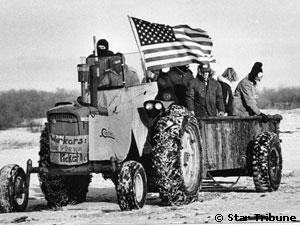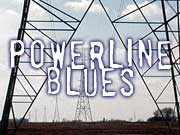'Rudy's Raiders' go home
December 9, 2002
 |
| Farmers on a manure spreader carried baseball bats and wore ski masks (Photo courtesy of Star Tribune) |
Undated — Charlie Broten wrote the song, Powerline Blues, for a farmers' meeting. He recorded it live with a band called the Prairie Crooners at the Lariat Lounge in the town of Cyrus in Pope County Minnesota in September 1977.
"I've lived on this farm since I was one day old, my mama's loving arms kept me warm from the cold.
I inherited the place when my daddy died, I paid the death taxes just like a was told.
But now this thing that I just don't understand.
"Well I heard it on the news, I read it in the Minneapolis Tribune.
They said they were going to condemn some of my best land, and make the power corridor across my land.
"Don't want no powerline. Don't want no powerline.
Lord this land is mine, and I don't want no powerline."
 | |||
Philip Martin, manager of the United Power Association, understood how the farmers felt. He'd grown up on a farm himself, in North Dakota, before serving in Korea and coming home to college and a job with the company. But as he saw it, he had no choice but to build the line. Each year, demand for his company's electricity was growing by as much as 10 percent.
UPA and a second utility, Cooperative Power Association -- CPA -- decided they could meet that demand by building a new power plant. They would put it near a cheap source of fuel, the coalfields of North Dakota. Then they'd ship the electricity to Minnesota through a 400-mile-long transmission line.
By the time the company realized it faced a showdown in west central Minnesota, construction on the North Dakota power plant was well underway. Interest on a $900 million federal loan was mounting. Workers were already stringing transmission line through North Dakota.
Philip Martin recalls that there, it met with only limited resistance. "We built all the way across North Dakota and we had one person protesting it. That was solved when the law enforcement -- he did some damage -- and the law enforcement there initiated the action to put him in prison, or jail. And pretty soon he said, 'I'll be a good boy, I won't do anything more,' and they let him out, and we built a transmission line. We didn't have any problem in North Dakota," says Martin.
Martin believed things would have gone far better in Minnesota if officers had treated protesters there the same way.
"The law enforcement refused to enforce their laws. We would go out and try to survey, and they would simply pull up all our stakes, they would destroy everything we had out there . And there was never anything done. President Norberg, who was president of the cooperative, and I were out there to many meetings. I drove a car with an escort in front of it and back of it with guns going off, sticking out the windows," he says.
"Whenever you'd hear them, they'd say, 'You're not ever going to build a transmission line through here. I mean, this is not going to happen. It's going to happen over my dead body.'"
"Virgil's mother I knew very well; she reminded me somewhat of my own mother. She used to just beg me, 'Don't build that transmission line, because it's going to do everything to this community, and it's going to hurt and everyone's going to get mad, and don't do this Mr...', she used to call me Mr. Phillips. And I loved her. But I couldn't meet her requirements of not building a transmission line," says Martin.
 | |||
The utilities began construction through west central Minnesota in November 1977. When farmers confronted the workers, the companies filed $500,000 lawsuits against five farmers.
Soon after, crowds at the protests dropped dramatically, but some were undeterred.
Farmer Gloria Woida spoke out at a public debate a few months after the companies filed suit against her husband, Matthew.
"Matt's being sued, my husband, for $500,000 for protesting against the line. What he did was, the surveyors had hit Stearns County, and on a dairy farm you have to clean your barn every day, in the winter especially. And he was down on the road with a side open tank spreader. And it was a good south wind, and God was with us. And everything turned just a little bit brown on some trucks, and I guess that's worth $500,000 worth of damages. Plus I've three arrests myself; I'm really not proud of that fact, but in order to protect my family, you'll see me arrested more," she said.
By then, getting arrested was about the only choice many farmers felt they had. They'd appealed lawsuits all the way to the Minnesota Supreme Court, but the Supreme Court had ruled against them.
For John and Alice Tripp, the struggle through the courts had been a revelation. "I had the feeling that it was all decided," John recalls. "The courts weren't acting as courts at all, they were just a front. And it was just a terrible, terrible shock to me. I thought, gee, this can't be."
Alice Tripp says she saw one official involved in the case meet with the judge. "And I thought, my goodness sakes, he can't go, you know, like that. I didn't think you could do that. But they did it." Virgil Fuchs felt the same disillusionment. He'd made his own tape recordings of public hearings on the powerline. He'd compared them with the official transcripts, and discovered that one third of the testimony was missing.
After he and others went to court, Fuchs's tape recordings were included as part of the official transcript, but he remained convinced that the whole process had been a sham, as he explained to lawmakers at a state Capitol hearing.
"This is the official record now, this would be page one of the Xerox copies. This is the record, by the way, that they're taking our property, it says, to irrigate under them," he said. "This is why the people are upset in the state of Minnesota. My God, if they can take our property by this kind of a technique, we have no rights left."
 | |||
By then, farmers were willing to listen to outsiders who they might have disregarded before; people like George Crocker, a long-haired 28-year-old who had spent a year and a half in prison for refusing to fight in Vietnam. Crocker moved from the Twin Cities to work full time on the protest.
"We had one of our meetings in Paynesville, at a restaurant there," John Tripp remembers. "But the room we were going to meet in was a little off the counter. It had doors on it and they were closed. And I was sitting there next to Mrs. Wolf, a farmer's wife from north of Sauk Center. And George Crocker and about four or five other people walked in, wearing their red bandannas. And this Mrs. Wolf turned to me and said, 'Are they going to meet in the same room with us?'"
"She later became quite an admirer of Crocker's," noted Alice Tripp. "There was a group of Quakers in the city called the Movement for a New Society, and they met with some of us somehow, to show us how to be arrested. And they're the ones that said, 'Lie down on the ground.' That's what I did. I lay down on the ground; it took four men to carry me to the police car. They put me in one door, I got out the other. But they got me back. But Patty saw that on TV, Patty Kakak the singer, and they were so impressed with this old lady being knocked around, that Patty came out the next day.
In early January 1978, protesters chased work crews away from three construction sites and scuffled with state troopers at a construction materials yard in Pope County. The companies announced they would halt work until they got more police protection.
Philip Martin, the United Power Association general manager, told a reporter for the Minneapolis Star, "We will see whether the law of the land will be enforced or whether these mobs will rule."
A day later, Gov. Perpich authorized the deployment of more than 100 state troopers to protect the construction crews.
"You know this is a nation of laws. And there's a lot of things that I don't like, you know, and I'm sure there's many things that you don't like, but there's a process that we can work, it's a process that's open. It's a process that people in November go and they make that mark on that ballot," Perpich said.
Gov. Perpich had tried hard to work out a compromise. His staff had held hundreds of hours of meetings with powerline opponents. And he'd proposed a special process called a Science Court to resolve the farmers' fears about health threats from the line.
The farmers weren't satisfied; they wanted a moratorium on construction while the Science Court proceeded. But Perpich felt he'd done all he could.
"If we didn't respond, and if we weren't responsive that's one thing. But I think that we did. And I think the hours that we spent on it…. And finally when you start knocking down state troopers and start doing damage, there isn't anything else but when the call is made. And so I keep appealing and I want to take these few minutes to appeal to the people for reason," Perpich said.
 | |||
TV crews from around the nation and from the BBC converged on the frozen fields of west central Minnesota. They anticipated a confrontation.
Instead, protesters offered the officers flowers and cookies and hot coffee. The big media departed, but the troopers remained.
So did the threat of violence. In the tiny town of Lowry, a banner reading Rudy's Raiders Go Home appeared over the pickups parked on Main St. Beside it dangled a figure of a state patrolman hung in effigy.
A Minneapolis Tribune reporter described "angry farmers screaming obscenities and thrusting baseball bats" at troopers. Newspaper photos showed farmers spraying anhydrous ammonia -- a farm fertilizer -- toward officers. It's highly caustic and can cause serious chemical burns if it contacts skin or eyes.
Another photo showed ski-masked farmers peering out windows bristling with BB gun barrels.
Every morning, farmers would gather in Lowry's Town Hall, a big second-story room above the fire station. First, they'd spend hours airing their grievances. Then they'd head out to confront powerline workers.
 | |||
Newspaper accounts described bands of farmers roaming the countryside in search of surveyors and leading groups of State Patrol officers on snowmobile chases through the windswept fields.
At the state Capitol that winter, lawmakers considered a moratorium on the powerline's construction. Witnesses testified before a House committee in February 1978.
Powerline opponents knew their main hope of stopping the line was to prove it posed a health threat. Gloria Woida read from a study prepared by the state health department.
"It says 'utilities should ground all fixed objects which would yield a shock current.' And the utilities themselves, I sat in a meeting with Mr. Dennis Russell, easement seeker, when he was out in Stearns County, and he said 'you must ground your buildings, your steel buildings. You must use a grounding bar on your machinery, and you cannot refuel under this line any gas vehicles or machinery.' Doesn't that tell you something? And, again, it continues, 'the companies should notify school districts that busses should not pick up or discharge passengers under overhead transmission lines.' Now I could go into much more detail in this book, but this is what the state of Minnesota themselves is saying. My gosh, we do need help. Do you see why we're asking for a moratorium?" she said.
Farmers also worried the line would harm their livestock. They knew that in some cases, electrical currents can damage conception rates and milk production in dairy cows.
No one knew what effect this powerline would have. It was a type known as direct current -- DCD -- rather than the usual alternating current -- AC. It was one of the very few DC lines of its size ever built in the United States.
Bob Lorenz, a veterinarian from Alexandria, had clients who farmed in the powerline's route. "Believe me, the sentiment and temper of these people right now is near an explosive-type state," he said. "They are not violent, but feel their backs are to the wall. If this line has to be built under constant police protection, what type of protection will be needed to keep it in operation upon completion? Presently I get stopped almost daily, and have my rights read, while taking calls in the area, and I'm told not to stop on certain roads. Yesterday, it took 10 squad cars and 20 state troopers to escort one truck of cement out of Alexandria. I really think we need to take a second look at this problem line and have a moratorium
But representatives of the utilities argued hard against it. Their attorney, John Dawes, testified that no other powerline in state history had gone through such a long review process.
"Over 30 public information meetings were held throughout central Minnesota . Over 50 public hearings were held for the purpose of taking testimony. Over 340 witnesses introduced over 500 exhibits and testified for almost 6,000 pages of transcripts," he said.
Dawes listed the utilities mounting costs as the powerline was delayed, and he warned state lawmakers that a moratorium would not survive a court challenge. And, finally, Dawes argued there was more at stake than money.
"The critical question for you as legislators is, is this a government of law, or of men? As a former justice of the Minnesota Supreme Court once said, once the law breaks down, it becomes so much the easier to break it down in other cases. That process does not continue long before all laws go to smash," he said.
Dawes arguments prevailed, and the bill for a moratorium died. But the farmers' movement refused to die.
"We had a tractor parade from Lowry to this farm, remember? I bet there were 8,000 people there, from all over the state," recalls Alice Tripp. "We had lot of people from the cities come up, remember? The used to come up to Lowry to join, and sometimes stayed at our farm, and sometimes in Lowry."
In an opinion poll two months later -- April 1978 -- the Minneapolis Tribune asked Minnesotans whether they sided with the farmers or the utilities. Sixty-three percent said they sided with the farmers. Among rural Minnesotans, support for the farmers ran at 70 percent.
That spring, Alice Tripp decided to run for governor.
|
News Headlines
|
Related Subjects
|

